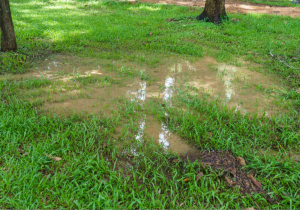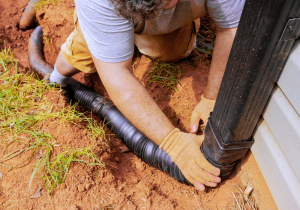Summer Storms and Your Drainage System: Preparing for Heavy Rainfall

Summer is a time for barbecues, pool parties, and… unexpected downpours? Indeed, summer storms can hit hard and fast, leaving homeowners scrambling to deal with sudden flooding and water damage. If you’re a homeowner, understanding the importance of a well-functioning drainage system during these heavy rains is crucial. This blog will walk you through practical tips and expert advice to ensure your drainage system is in top shape before the next big storm hits.
Signs Your Drainage System is Inadequate
Before you can prepare your drainage system for heavy rainfall, it’s essential to know if it’s currently up to the task. Here are some red flags that indicate your drainage system may need some attention.
 Water Pooling Around Your Home
Water Pooling Around Your Home
One of the most telling signs of an inadequate drainage system is water pooling around your home. If you notice puddles forming near the foundation after a storm, it might be time to investigate further. This can lead to structural damage over time.
Slow-Draining Gutters and Downspouts
Another sign is slow-draining gutters and downspouts. When these systems are clogged or inefficient, they can’t effectively direct rainwater away from your home. Check for overflowing gutters during a downpour; if water is spilling over the edges, it’s a clear sign of a problem.
Musty Odors and Mold Growth
Musty odours and unexpected mould growth in your basement or crawl spaces can also indicate poor drainage. When water doesn’t drain properly, it can seep into these areas, creating an ideal environment for mould and mildew to thrive.
DIY Maintenance Tips to Prepare Your Drainage for Heavy Rainfall
Taking a proactive approach can save you from costly repairs down the line. Here are some DIY tips to prepare your drainage system for those inevitable summer storms.
Clean Your Gutters and Downspouts
One of the simplest yet most effective steps is cleaning your gutters and downspouts. Remove debris like leaves and twigs that can block the flow of water. A clear pathway ensures that rainwater is directed away from your home efficiently.
Inspect and Repair Cracks in Your Foundation
Small cracks in your foundation can become problematic during heavy rainfall. Inspect your foundation for any visible cracks and seal them with waterproofing materials. This prevents water from seeping into your home’s structure.
Install or Upgrade Your Sump Pump
If your home has a basement, a sump pump is a must-have. Ensure your existing sump pump is in good working condition, or consider upgrading to a more powerful model. A reliable sump pump can prevent basement flooding, giving you peace of mind during storms.
The Importance of Professional Inspections and Maintenance
While DIY tips are helpful, there’s no substitute for professional inspections and maintenance. Here’s why you should consider bringing in the experts.
 Professional Expertise and Equipment
Professional Expertise and Equipment
Professionals come equipped with the knowledge and tools needed to thoroughly inspect your drainage system. They can identify issues that might not be visible to the untrained eye, ensuring nothing is overlooked.
Long-Term Cost Savings
Investing in professional maintenance can save you money in the long run. Addressing minor issues before they escalate into major problems can prevent costly repairs and water damage down the line.
Peace of Mind
Knowing that your drainage system has been inspected and maintained by professionals provides invaluable peace of mind. You can rest easy during a storm, confident that your home is well-protected.
Sustainable Drainage Solutions for Future-Proofing Your Home
In an era of increasing environmental awareness, sustainable drainage solutions are gaining popularity. Here are some eco-friendly options to consider.
Rain Gardens
Rain gardens are a beautiful and sustainable way to manage excess water. These gardens are designed to absorb and filter rainwater, reducing runoff and preventing erosion. They also add aesthetic value to your property.
Permeable Paving
Traditional paving materials can contribute to water runoff and flooding. Permeable paving, on the other hand, allows water to seep through and be absorbed by the ground. This reduces the strain on your drainage system and helps replenish groundwater supplies.
Green Roofs
Green roofs are another innovative solution. By covering your roof with vegetation, you can absorb rainwater, reduce runoff, and insulate your home. Green roofs also contribute to better air quality and biodiversity.
Summer storms may be unpredictable, but your preparedness doesn’t have to be affected. By understanding the signs of an inadequate drainage system, taking proactive DIY steps, enlisting professional help, and considering sustainable solutions, you can ensure your home is ready to handle whatever Mother Nature throws your way.
